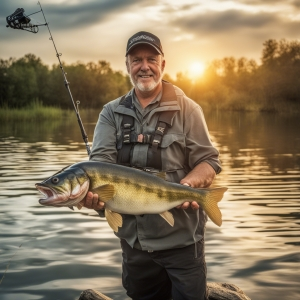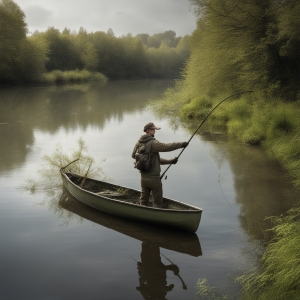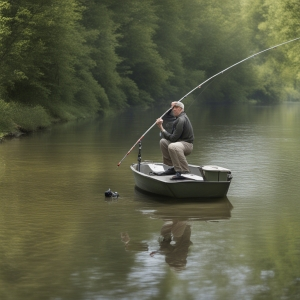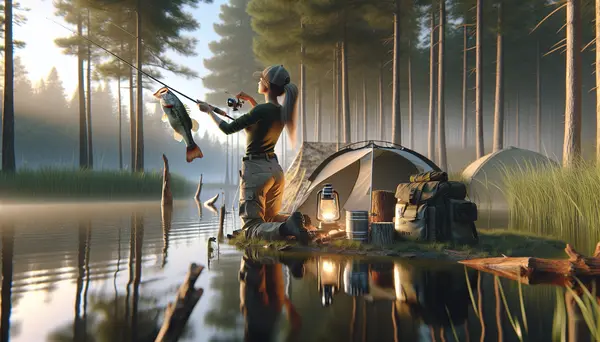Table of Contents:
Introduction: Diving Into The Exciting World of Bass Fishing
Whether you are a seasoned angler or a beginner, bass fishing brings its unique set of challenges and rewards. However, with the right tactics, it's an exciting sport you can quickly get the hang of. In this article, we'll delve into the exciting world of bass fishing. You'll get a glimpse of insight from professional anglers and tips that can turn your angling game around. Dive in and let's uncover the secrets behind attracting and catching those elusive bass!
Understanding Bass Behavior: A Fundamental Step for Successful Fishing
Bass, similar to us humans, have their own distinctive behavior patterns. Recognizing these patterns is integral to being successful in bass fishing. To be an effective angler, understanding where bass are most likely to be found depending on the weather, water conditions, and the time of year can go a long way. Recognizing their feeding and mating habits can also considerably improve your fishing experience. This approach heightens the fascination of the sport as you learn more about this intriguing species.
Tactics to Consider for Pro Bass Fishing
| Pros | Cons |
|---|---|
| Using live bait can increase chances of catching bass | Live bait can be difficult to maintain and keep alive |
| Early morning fishing could bring larger catches | Early mornings might be inconvenient and cold |
| Fishing in deep water may yield larger bass | Finding the right depth can be a challenge |
| Using specialized lures could improve success | Specialized lures can be expensive |
| Varying your retrieval speed can trick more bass | Requires practice to perfect the technique |
Bass Fishing Techniques: Tips Straight from A Pro Angler

Professional anglers know that bass fishing requires the right skill set and technique. Here are their top tips straight from the source. First of all, timing is everything. Early morning and late evening are the best times for bass fishing. The second vital point is choice of bait. Minnows, jigs, and crankbaits are some examples of effective bass fishing lures. Another insider tip is knowing how to cast. Learning different casting styles can dramatically improve your catch rate.
Further into the technique, pros emphasize the importance of mastering the pitching and flipping methods. These techniques allow for quiet, accurate casts, especially in heavy cover areas where bass tend to hide. Equal importance is given to learning the drop-shotting technique. It is particularly useful when bass are located deep underwater or are not biting.
In summary, the bottom line of pro angling advice revolves around the right timing, bait choice, casting, and using specialized techniques for specific conditions.
Choosing The Right Gear: Each Tool Makes a Difference in Bass Fishing
When it comes to bass fishing, the right gear can make a significant difference in your success. From the fishing rod to the line strength, and the hook, each tool plays a vital role in catching a bass.
Firstly, your fishing rod should be neither too stiff nor too flexible. A medium-heavy rod is effective and efficient for bass fishing suits. It offers the right combination of sensitivity and power making it easier to detect bites and to fight the fish.
Your fishing line strength should suit the weight of the bass you're targeting. A light line may snap under the weight of a large bass, while a heavy line might be visible to the fish and deter them from biting. Pro anglers recommend a monofilament or braided line as these lines offer both strength and low visibility.
Your choice of hook should match the size of your bait. Small hooks could be easily swallowed and may not get a good hold, whereas large hooks might be detected by the fish. Hooks with a wide gap, like the offset round bend variety, are excellent for bass fishing as they have better chances of hooking the fish.
Lastly, don't forget the importance of a good baitcasting reel. A reel with a high gear ratio will help retrieve the bait faster, making it more tempting for the bass. Ensure that the reel you choose has durable components, holds enough line for long casts, and features a smooth drag system.
Remember, having the right gear is not about the brand or the price tag attached, but rather its suitability to the task at hand- catching bass!
Bass Fishing Locations: Knowledge on Where To Cast Your Line

Bass, both large and small, inhabit a vast array of habitats, and as an angler, understanding these habitats can make your fishing excursions more rewarding. Bass tend to favor structures or cover like submerged trees, rocks, docks, and water vegetation as these provide them an ideal place to hide and hunt for prey.
When you're fishing in a lake, it's often a good idea to find areas where there is a sudden change in the depth of the water or some form of structure, popularly known as points. Similarly, rivers with currents could get you some bass action. Plus, they enjoy residing in cuts and field channels.
Bass are also prominent in reservoirs, especially those with slow-moving or still water. They often gather near the dam or in coves. Moreover, don't overlook ponds, as they can also be hotspots for bass, thanks to the confined space and plenty of prey available.
Even though fishing locations might vary, one thing remains constant: bass love cover, so anglers should always concentrate their efforts around areas of significant structure or changes in depth. Remember, understanding where to cast your line is just as crucial as what you have at the end of it. Your tackle box might be full of lures, but without the right location, you're merely wetting a line.
Seasonal Strategies: Adapting Bass Fishing Tactics for Changing Seasons
Seasons play a vital role in bass fishing. Changing weather conditions influence how, when, and where bass feed, influencing your bass fishing strategies. Knowledge about the behavioral change of bass over different seasons is thus a crucial tool for the seasoned angler.
Spring is a golden period for bass fishing. As the water starts to warm, bass move from deep to shallow waters preparing for the spawn. This is the time to fish around structures where they might be hiding.
Things change in the summer where bass often go deeper to escape the high temperatures. Fishing early morning or late evening when temperatures are cooler can yield better results.
During fall, bass tend to feed heavily in anticipation of the colder months. Look out for areas where they might be feeding, commonly any place with abundantly active baitfish or crawfish.
Finally, bass fishing during winter requires a specific set of tactics. Bass activity slows down in cold water conditions, and so should your lures. Slowing down your retrieval rate can do the trick in these chilly conditions.
In summary, understanding and adapting to the seasonal changes in bass behavior can greatly hike up your chances of successful bass fishing.
Catch, Release, Repeat: Sustainability in Bass Fishing

In bass fishing, one of the key aspects to consider is sustainability. It's not just about the thrill of the catch, but also about respecting the ecosystem and ensuring the survival of the species. This is where the practice of 'Catch, Release, Repeat' comes into play.
The idea behind Catch, Release, Repeat is simple: once you've had the satisfaction of reeling in your catch, you gently return the fish back into the water, allowing it to continue its life. This not only helps maintain the balance of the ecosystem but also ensures that there are plenty of fish available for future fishing adventures.
There are a few things to keep in mind when releasing a fish. First, avoid unnecessary handling and make sure your hands are wet before touching the fish to protect its sensitive scales and slime coat. Secondly, remove the hook carefully without causing damage. If the fish has swallowed the hook, it's better to cut the line as close as you can to the hook and release the fish.
In essence, sustainable bass fishing requires a focus on the welfare of the fish and the environment. With mindful fishing practices like Catch, Release, Repeat, we can continue to enjoy the sport and preserve the waters and their inhabitants for generations to come.
Conclusion: Embarking on Your Own Bass Fishing Journey
In conclusion, bass fishing is a sport that combines patience, skill, and the thrill of the catch. The tips and tactics outlined in this article will give you a strong foundation for a successful fishing outing. Becoming skilled at bass fishing is a journey, one that gives you the unique opportunity to deepen your connection with nature and its water-bound inhabitants. With knowledge, the right gear, and a healthy dose of perseverance, you are well on your way to becoming a successful bass angler.
Remember, every fishing trip is a learning experience. Don't be disheartened if the fish aren't biting. Be patient, keep your lines wet, and the bass will come. As you embark on your bass fishing journey, always respect nature and follow the rules and regulations of the area you are fishing in. Happy fishing!
Guidelines for Successful Bass Fishing
What are the basics of Bass fishing?
Bass fishing involves understanding the species behavior, habitats, and the use of appropriate fishing gear. It is also influenced by the season, weather conditions, and the size of the pond or lake.
What is the best time for Bass Fishing?
The best time for bass fishing is in the early morning hours at sunrise or late afternoon until dusk. Bass tend to avoid the sunlight, so these are the optimal times when they will be feeding.
What is the best bait for Bass Fishing?
The best bait depends on the time of the year. In warmer temperatures, soft plastic worms and minnows work best. In cooler temps, crankbaits and spinnerbaits are more effective.
What kind of rod is best for Bass Fishing?
A medium-heavy rod with fast action is generally suitable for bass fishing. It provides the versatility to handle various types of baits and lures.
What weather is best for Bass Fishing?
Overcast or mild rainy conditions are ideal for bass fishing. Bass are more likely to bite when the ambient light levels are lower.







